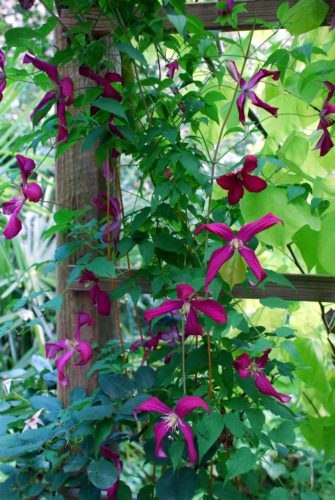
Flowering vines, climbers and twiners welcome visitors to Ryan Gainey’s garden. Cercis canadensis ‘Forest Pansy’ and C. canadensis ‘Hearts of Gold’ are trained on an arbor with roses and clematis.
Fragrant bowers of roses, long canopied walks adrift with fallen petals of clematis, shady nooks perfumed with sweet jasmine. These romantic visions are created using plants whose normal tendencies are to climb, to ramble, or to twine. My Decatur, Georgia, garden is full of these rambling, twining, and flowering vines. They allow me to layer color upon fragrance upon texture.

Clematis growing on C. canadensis ‘Hearts of Gold’
The startling combination of deep-violet clematis blossoms peeking through the golden foliage of Cercis canadensis ‘Hearts of Gold’ is mine, because I have chosen to take advantage of the clematis’s propensity to twine its way up towards the light. The late renowned garden designer Rosemary Verey was an avid plant collector, and finding space in her garden for a new treasure was difficult. It was she who taught me to grow clematis through and on top of shrubs. She didn’t have many arbors or pergolas in her garden, so this was a way to add seasonal color to plants grown primarily for their foliage.

‘New Dawn’ roses trained on a series of rebar hoops intertwined with Confederate jasmine (for fragrance), clematis, and climbing asters. Three climbers, ramblers, and twiners I particularly enjoy in my own garden are roses, clematis, and jasmine.
Roses
The ‘New Dawn’ rose variety is really a sprawler. It grows beautifully with large pale-pink blooms on long canes reaching 10 to 15 feet. I say it is a sprawler, because roses do not have tendrils or a natural tendency to wind themselves around a support. It is the gardener who weaves those long canes into a fence or ties them onto the pergola and helps the rose achieve its goal of reaching for the sun. ‘New Dawn’ is only one of many roses that can be used in this way.

One of Gainey’s favorite flowering vines, C. viticella ‘Etoile Violette,’ on an arbor
Clematis
Clematis viticella ‘Etoile Violette’ is perhaps my favorite clematis, with its small flowers and bright, clear-purple color. Clematis need no training; their natural tendency is to use their tendrils to reach for the sun. Don’t buy your clematis through the mail. Go to a garden center and buy established 1-gallon (or if you can find them, 3-gallon) pots. Then plant the clematis where they can reach up to the light but keep their roots shaded. Plant ground covers at their base or even laying flat rocks around the roots to keep them cool.
Jasmine
Guide jasmine’s long runners onto whatever you choose. This plant makes a beautiful (and in my area, evergreen) living fence. I grow white and pale yellow varieties of Trachelospermum jasminoides, commonly called Confederate jasmine. Native to Asia, these plants grow runners that can reach 8 to 10 feet. Weave them into their support. As the plants become established you can shear them into a thick wall of glossy, dark-green leaves.
Fall is a particularly good time to look for flowering vines, climbers, and ramblers in your local nursery. Large specimen plants that have been carefully handled all summer will give you a head start on a bountiful spring display. For helpful suggestions on plant varieties suited to your area and how to create the proper supports, you might enjoy reading Ramblers, Scramblers & Twiners by M. J. Jefferson-Brown (David & Charles, 2000).
Having rambling, twining plants in the garden—like the roses, clematis, and jasmine I have in mine—is not without its bit of work (pruning and guiding), but when the result is something this romantic and charming, the gardener is well rewarded for the effort.
By Ryan Gainey
Photography by Jeffrey Lee Adler
You can purchase Ramblers, Scramblers & Twiners by M. J. Jefferson-Brown (David & Charles, 2000) at our Flower Magazine shop.
The late garden designer and author, Ryan Gainey wrote a regular column in Flower for many years, sharing his remarkable gardening knowledge and stories. See more from Gainey’s garden:




